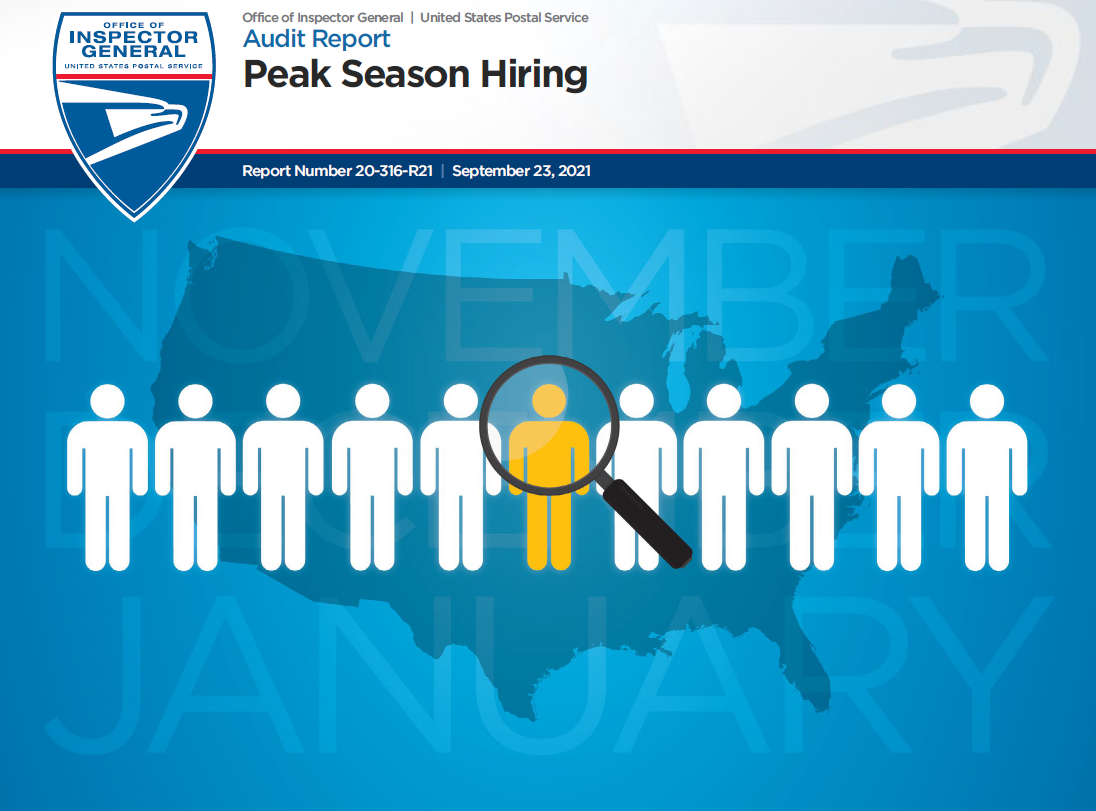
Objective
Our objective was to assess whether the Postal Service effectively hired bargaining employees for the peak season periods of 2019 through 2021.
Peak season employees help ensure that Postal Service customers receive quality mail service and parcels on-time during the holiday season. Individuals hired during peak season are non-career bargaining unit employees who supplement existing staffing and work from November until January. These individuals include postal support employee clerks and city carrier assistants. Peak season dates for 2019 through 2021 were:
- 2019: November 10, 2018, through January 4, 2019.
- 2020: November 9, 2019, through January 3, 2020.
- 2021: November 7, 2020, through January 1, 2021.
However, this season extended through March 26, 2021 due, in part, to COVID-19.
In September 2019, the Postal Service adopted a fast track hiring process. The goals of fast track hiring included shortening the time for extending job offers and getting applicants on the rolls, as well as eliminating interviews for 67 bargaining positions. Fast track is now considered the normal hiring process for all applicants, not just peak season hires.
Findings
While the Postal Service met its 2021 peak season hiring goals, it did not always fill peak season positions timely. We statistically sampled 203 positions from peak season 2019 to 2021 and found that 195 of them (96 percent) were open longer than the suggested guidance for filling temporary positions.
Specifically, of the 195 positions noted:
- For non-driving positions that did not require an interview, 144 (74 percent) were open over 17 days. Suggested guidance for fast track hiring notes that the Postal Service should fill non-driving positions within 14 to 17 days (from posting to hiring).
- Fifty-one (26 percent) positions with an interview requirement for hire were delayed. Non-driving positions requiring an interview should be filled within 26 days and driving positions requiring an interview should be filled within 29 days.
Peak season positions were not filled timely because the Postal Service did not monitor hiring activities, to include following up with hiring officials when officials did not complete their required activities timely. Additionally, the suggested guidance for temporary positions did not always reflect the actual time spent on completing peak season hiring activities. For example, the Postal Service could not fill positions within suggested guidance timeframes because there could be a large number of candidates to evaluate or delays in interim background investigations. The guidance did not consider these situations.
When the Postal Service does not fill open peak season positions timely, there is an increased risk of those staff shortages negatively affecting service performance, employee availability, overtime, and the workload of other peak season employees.
Additionally, management has a process for projecting resources to manage peak season mail and package volume that varies by facility location, current staffing levels, and operational needs. According to its projections, the number of individuals hired by the Postal Service for peak season 2021 should have been sufficient to provide coverage of the operations. During COVID-19, though, declining mail and increasing package volume created operational challenges that were compounded by workforce and transportation issues. Mail processing facilities did not always have adequate staff to manage the increased package volume during peak season, even though the Postal Service met its 2021 peak season hiring goals.
However, management did not meet its hiring goals for peak seasons 2019 and 2020. The Postal Service hired only 69 percent and 87 percent, respectively, of its projected hires. These issues occurred because the Postal Service did not have a formal, standardized process or strategy in place to address current and past recruiting challenges during peak season.
Further, there were no specific requirements or controls established to assess the return on investment or evaluate the effectiveness of resources spent for peak season recruiting activities.
Management is considering a new strategy for tracking the effectiveness of digital outlets to evaluate funds obligated for recruiting efforts. Additionally, in response to our audit, management is developing finance numbers for Field Recruitment and Veterans Recognition programs to track recruiting expenses. As a result, we will not make a recommendation to track recruiting expenses.
Without a formal strategy to address recruiting challenges, there is an increased risk there will not be enough employees available to achieve maximum productivity and meet service performance standards during peak season, affecting customer service.
Recommendations
We recommend management:
- Establish and implement formal timeframes for peak season hiring activities that reflect actual hiring operations.
- Establish and implement a formal monitoring program over the peak season hiring process to help ensure hiring officials complete their hiring activities in a timely manner.
- Develop a strategy that includes an action plan to address peak season hiring challenges and performance indicators to assess peak season recruiting activities.
Read full report
Source: USPS Office of Inspector General
